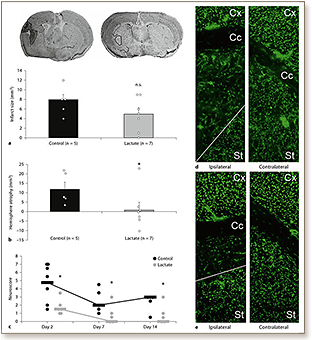 Background: Lactate protects mice against the ischaemic damage resulting from transient middle cerebral artery occlusion (MCAO) when administered intracerebroventricularly at reperfusion, yielding smaller lesion sizes and a better neurological outcome 48 h after ischaemia. We have now tested whether the beneficial effect of lactate is long-lasting and if lactate can be administered intravenously. Methods: Male ICR-CD1 mice were subjected to 15-min suture MCAO under xylazine + ketamine anaesthesia. Na l-lactate (2 μl of 100 mmol/l) or vehicle was administered intracerebroventricularly at reperfusion. The neurological deficit was evaluated using a composite deficit score based on the neurological score, the rotarod test and the beam walking test. Mice were sacrificed at 14 days. In a second set of experiments, Na l-lactate (1 μmol/g body weight) was administered intravenously into the tail vein at reperfusion. The neurological deficit and the lesion volume were measured at 48 h. Results: Intracerebroventricularly injected lactate induced sustained neuroprotection shown by smaller neurological deficits at 7 days (median = 0, min = 0, max = 3, n = 7 vs. median = 2, min = 1, max = 4.5, n = 5, p < 0.05) and 14 days after ischaemia (median = 0, min = 0, max = 3, n = 7 vs. median = 3, min = 0.5, max = 3, n = 7, p = 0.05). Reduced tissue damage was demonstrated by attenuated hemispheric atrophy at 14 days (1.3 ± 4.0 mm3, n = 7 vs. 12.1 ± 3.8 mm3, n = 5, p < 0.05) in lactate-treated animals. Systemic intravenous lactate administration was also neuroprotective and attenuated the deficit (median = 1, min = 0, max = 2.5, n = 12) compared to vehicle treatment (median = 1.5, min = 1, max = 8, n = 12, p < 0.05) as well as the lesion volume at 48 h (13.7 ± 12.2 mm3, n = 12 vs. 29.6 ± 25.4 mm3, n = 12, p < 0.05). Conclusions: The beneficial effect of lactate is long-lasting: lactate protects the mouse brain against ischaemic damage when supplied intracerebroventricularly during reperfusion with behavioural and histological benefits persisting 2 weeks after ischaemia. Importantly, lactate also protects after systemic intravenous administration, a more suitable route of administration in a clinical emergency setting. These findings provide further steps to bring this physiological, commonly available and inexpensive neuroprotectant closer to clinical translation for stroke.
Background: Lactate protects mice against the ischaemic damage resulting from transient middle cerebral artery occlusion (MCAO) when administered intracerebroventricularly at reperfusion, yielding smaller lesion sizes and a better neurological outcome 48 h after ischaemia. We have now tested whether the beneficial effect of lactate is long-lasting and if lactate can be administered intravenously. Methods: Male ICR-CD1 mice were subjected to 15-min suture MCAO under xylazine + ketamine anaesthesia. Na l-lactate (2 μl of 100 mmol/l) or vehicle was administered intracerebroventricularly at reperfusion. The neurological deficit was evaluated using a composite deficit score based on the neurological score, the rotarod test and the beam walking test. Mice were sacrificed at 14 days. In a second set of experiments, Na l-lactate (1 μmol/g body weight) was administered intravenously into the tail vein at reperfusion. The neurological deficit and the lesion volume were measured at 48 h. Results: Intracerebroventricularly injected lactate induced sustained neuroprotection shown by smaller neurological deficits at 7 days (median = 0, min = 0, max = 3, n = 7 vs. median = 2, min = 1, max = 4.5, n = 5, p < 0.05) and 14 days after ischaemia (median = 0, min = 0, max = 3, n = 7 vs. median = 3, min = 0.5, max = 3, n = 7, p = 0.05). Reduced tissue damage was demonstrated by attenuated hemispheric atrophy at 14 days (1.3 ± 4.0 mm3, n = 7 vs. 12.1 ± 3.8 mm3, n = 5, p < 0.05) in lactate-treated animals. Systemic intravenous lactate administration was also neuroprotective and attenuated the deficit (median = 1, min = 0, max = 2.5, n = 12) compared to vehicle treatment (median = 1.5, min = 1, max = 8, n = 12, p < 0.05) as well as the lesion volume at 48 h (13.7 ± 12.2 mm3, n = 12 vs. 29.6 ± 25.4 mm3, n = 12, p < 0.05). Conclusions: The beneficial effect of lactate is long-lasting: lactate protects the mouse brain against ischaemic damage when supplied intracerebroventricularly during reperfusion with behavioural and histological benefits persisting 2 weeks after ischaemia. Importantly, lactate also protects after systemic intravenous administration, a more suitable route of administration in a clinical emergency setting. These findings provide further steps to bring this physiological, commonly available and inexpensive neuroprotectant closer to clinical translation for stroke.